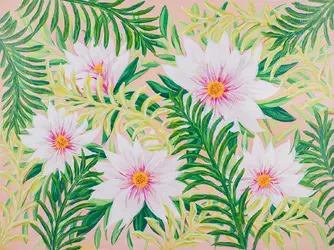frommrstomommy
Been spending a lot of time on here!
- Joined
- Feb 3, 2010
- Messages
- 2,345
- Reaction score
- 1,003
- Location
- florida
- Can others edit my Photos
- Photos OK to edit
Hello all,
I have not posted here in what feels like a lifetime, but this forum was incredibly helpful to me when I first started my hobbyist photography journey. That was like 12 years ago? Wow!
I have been photographing products over the last ~6 years or so and doing some graphic design work. I am niched down and moving along there more or less, but a year ago I started painting in acrylics. I am having the time of my life but struggling to photograph my artwork. I have been using a simple lighting setup that works well for most of my other work: 2 godox strobes with softboxes (strip style in case this matters though hoping not because space!!) and a clean white background. However, I feel like I am running into a few issues. On larger works I am getting a lot of sheen in the paints creating a glare on the far ends nearest the lighting sources. I can work around this somewhat with positioning but the bigger I paint, the harder that gets to avoid. I am also struggling with all colors to look accurate SOOC or post editing. My lighter backgrounds are either too light or more muted in color than they are in real life. Certain colors photograph spot on, and then others are all over the place it seems. I am of course playing with my HSL sliders in Lightroom but finding it tricky to get accurate color representation.
I also honestly think my vision is going downhill due to some health issues I have and I no longer really trust my eyes, which could very well be part of my problem. Does anyone have any suggestions there?
Does anyone here photograph paintings? I would love to know what you are using for lighting.
Thank you in advance for any help or suggestions.
Bonnie
I have not posted here in what feels like a lifetime, but this forum was incredibly helpful to me when I first started my hobbyist photography journey. That was like 12 years ago? Wow!
I have been photographing products over the last ~6 years or so and doing some graphic design work. I am niched down and moving along there more or less, but a year ago I started painting in acrylics. I am having the time of my life but struggling to photograph my artwork. I have been using a simple lighting setup that works well for most of my other work: 2 godox strobes with softboxes (strip style in case this matters though hoping not because space!!) and a clean white background. However, I feel like I am running into a few issues. On larger works I am getting a lot of sheen in the paints creating a glare on the far ends nearest the lighting sources. I can work around this somewhat with positioning but the bigger I paint, the harder that gets to avoid. I am also struggling with all colors to look accurate SOOC or post editing. My lighter backgrounds are either too light or more muted in color than they are in real life. Certain colors photograph spot on, and then others are all over the place it seems. I am of course playing with my HSL sliders in Lightroom but finding it tricky to get accurate color representation.
I also honestly think my vision is going downhill due to some health issues I have and I no longer really trust my eyes, which could very well be part of my problem. Does anyone have any suggestions there?
Does anyone here photograph paintings? I would love to know what you are using for lighting.
Thank you in advance for any help or suggestions.
Bonnie










![[No title]](/data/xfmg/thumbnail/37/37613-6b200847731e552bb4bf9ba3bdb80183.jpg?1734170739)





